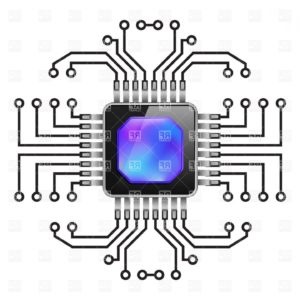In 2009 Intel came out with the iCore Processor series. These were I Core 3 I Core5 I Core 7 released in 2009. I could write a term paper on processors, but this is the short version. First we need to point out the difference between desktop processors and laptop processors. Laptop computers are made to be portable. Intel designed two different processors for laptops. The “U” series is the low voltage processor. These are made to run at a lower Gigahertz “or less power used.” These processors can allow a laptop to reach up to 8 hours of average use. The downside is the lower gigahertz processors are slower. The other laptop processors are numbered with a different series number. These processors use more power but they are faster and more responsive.
The desktop processor versions being powered by AC current are not designed with power saving in mind. Basically the more Gigahertz or “GHZ” the better. Ram and “BUS” speed also contribute to the speed of the processor. For now I am only concerned with the processors.
To make things a little more confusing there are now eight generations of each I Core processor. When you see an ad for an Intel I core 5 processor don’t get too excited. A third generation I Core 3 processor will blow away a first generation I Core 3 processor. With laptops this is always true. Sometimes a desktop first generation I Core 5 will be faster. Looking at laptops almost all I Core 3 and 5 are dual core. Each core has 2 threads so some people will advertise these as having 4 logical cores. This is true, but 4 logical cores do not make a real quad core processor. A laptop I Core 7 is a true quad core processor with 8 logical cores.
There are other factors like how much “Cache” a processor has and other more obscure information. For this article I am going to stick with information designed for the average user. With an Intel processor the big change happens when the generation is third generation or above. With the third generation processors you get the faster 3.0 USB ports Turb0-Boost as well as better graphics. Why is this so important? If you ever need to download a lot of information the 3.0 USB port is “10 times as fast as the “2.0 USB”. The Turbo-Boost allows your processor to get more processing power when it needs it the most. In my opinion after the third generation you really don’t get a lot more for your money.
The desktop processors are all about speed! The difference between an Intel I Core 3 and an I Core 5 is usually about $80 to $100 dollars. If you can afford it get the I Core 5. Now some people just want the best, fastest tech gear out there. For those people there are a lot of options. The down side for them is what was the best last month can become old tech in a hurry. Knowing what you are going to want from your computer is very important. It’s like deciding if you should buy a home with a two car garage or a three car garage. If you feel that you “can make a two garage work” chances are you will regret that choice in a few years. Always get a little more than you think you will need. There is nothing more expensive than buying the wrong computer the first time. Usually the next step up from what you think you might need is only $50 to $100 more.
This article is not for special need folks! If you are a gamer or a high end photographer you have special needs. Do your research designed for your specific needs.
One last thing to cover that has nothing to do with the processor. There is nothing that will add more speed to a computer than a solid state hard drive. A solid state hard drive is 5 to 10 times as fast as a spindle hard drive. When you start talking 5 to 10 times as fast, it is worth a little research. You can read my article on solid state hard drives on my media page.

